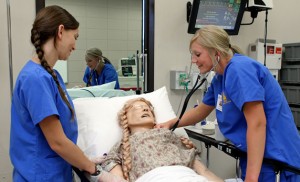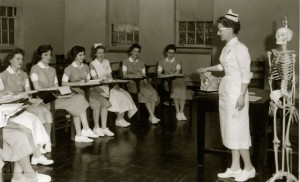From Mrs. Chase to the Sim Family
Nursing students from earlier generations met someone they never forgot when they went to college — Mrs. Chase.
She never filled the role of dean, department head, faculty member or even lab tech, but she quietly made her impact on virtually every student from at least the 1950s to the early 1980s. She was a low-tech mannequin made by a Connecticut company.
Marge Hegge, who began teaching at SDSU in 1969, recalled that her students’ version of Mrs. Chase had no arms.
Mrs. Chase cooperated while students learned to bath a patient, turn a patient in bed, and to detect signs and symptoms of mankind’s infections.
Mrs. Chase at State
Martha Iken, who started her nursing education at State in 1973 and taught here from 1980 to 2003, notes that she often spoke on behalf of Mrs. Chase when her students were putting in a nasal gastric tube to deliver medications or drain the stomach.
 Iken said she would cough as if the tube was going into the lungs rather than the esophagus.
Iken said she would cough as if the tube was going into the lungs rather than the esophagus.
She said when students were inserting a Foley catheter, “I would tell them they couldn’t press on my (Mrs. Chase’s) legs.†When students applied Betadine to clean the area around the urethra, Iken would say, “Didn’t I tell you I was allergic to that†if students forgot to first check with Mrs. Chase.
Today, the faculty are silent while the computer-enhanced mannequin talks.
SDSU received its first simulation mannequin in time for classes in fall 2006. The family has been growing since then.
Associate Professor Lois Tschetter says, “We are developing a multigenerational family, so students will interact with various family members throughout their simulation experiences. The mannequin will take on different names, appearances and medical conditions depending on the individual simulation scenario.â€
Decades earlier, nursing students only had to keep tabs on Mrs. Chase.
The SimMan Patient Simulator family now includes Martha and George Jackson, their son, John Jackson, and his wife Bonnie (known as Bunny at the Jackrabbit college); the grandchildren — JJ, TJ and Abby; and Walter and Gladys Conn (derived from CON—College of Nursing).
The Sim family is as complex as it is diverse.
With pulses, preprogrammed heart, lung, bowels, and vocal sounds, and more than 2,500 cardiac rhythms, SimMan will do everything except get out of bed. In fact, the $50,000 mannequin can even be programmed to die.
IVs via computer
In the generation between Mrs. Chase and SimMan, students used a rubber arm that felt like skin to learn to insert an IV. Today, third-semester students learn from a computer program in which the mouse pad moves the needle.
“You have a feel of where it is going but you don’t actually stick anything,†Hegge said.
By the fourth and fifth semester, student nurses are practicing on real patients. Students in the traditional baccalaureate program earn their nursing degree in four years — three semesters of pre-nursing coursework and five semesters within the program.
History dates to 1935
In the beginning, it was a five-year program with Sioux Valley Hospital in Sioux Falls furnishing three years of clinical experience.
In 1935, at the request of the South Dakota Nurses’ Association, a department of nursing was established within the Division of Pharmacy.
Five received diplomas with the first graduating class — 1936. In 1952, the four-year program was instituted and Inez Hinsvark and Doris Mae Coles joined R. Esther Erickson on the faculty. In 1955, clinical sites were established in Watertown, Madison, Rapid City, and St. Paul, Minn., with the Sioux Valley contract terminated.
In 1956, the first four-year class graduated and Helen Gilkey became the first dean of newly created Division of Nursing.
Dave Graves






